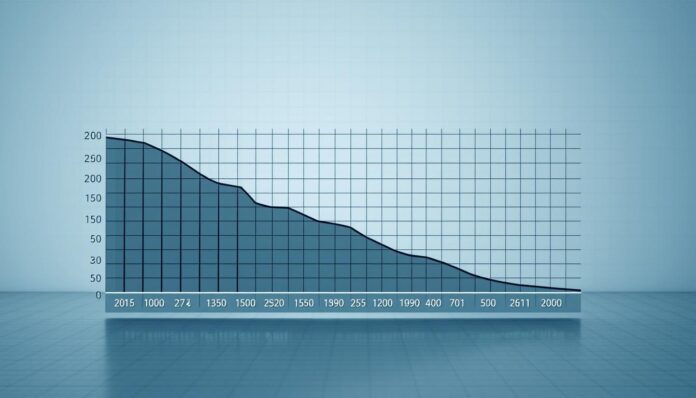Economic depreciation refers to the loss in value of an asset over time due to economic conditions like market changes or reduced demand. This concept helps businesses and investors assess true asset worth. The economic depreciation definition focuses on real-world factors, unlike accounting methods. Let’s explore what is economic depreciation and why it matters for decision-making.
Understanding economic depreciation starts with recognizing how assets lose value beyond physical wear. It impacts everything from tax strategies to long-term investments. By grasping the basics of economic depreciation, readers can better navigate financial planning and market trends.
Key Takeaways
- Economic depreciation measures value loss from external economic factors.
- It differs from accounting depreciation used in financial statements.
- Key drivers include market shifts and changes in consumer preferences.
- Affects business strategies for asset management and tax benefits.
- Crucial for accurate valuation of properties and equipment.
Understanding Economic Depreciation
To truly grasp financial health, start with the economic depreciation definition. This concept measures how an asset’s market value declines due to external factors like industry trends or economic shifts. Unlike accounting methods focused on cost allocation, economic depreciation reflects real-world changes affecting business decisions.
Definition of Economic Depreciation
At its core, economic depreciation tracks the loss in an asset’s market value over time. For instance, a factory machine may lose value faster if newer technology emerges. This economic depreciation definition Consider a tech company: outdated equipment loses value quickly as competitors innovate, illustrating this decline in real terms.
Importance in Financial Reporting
The significance of economic depreciation lies in its role in accurate reporting. Here’s why it matters:
- It reveals true asset value, helping businesses avoid overvaluing resources.
- Investors rely on it to assess long-term risks and growth potential.
- Regulators and auditors use it to ensure compliance with real-world market conditions.
Without tracking this decline, financial statements might mislead stakeholders about a company’s actual economic position.
The Concept of Depreciation
At its core, depreciation in economics involves tracking how assets lose value over time. While this process is critical for businesses, understanding it starts by contrasting it with its opposite: appreciation. Let’s explore these concepts and the methods used to measure them.
How Depreciation Differs from Appreciation
Depreciation and appreciation are two sides of the same coin. While depreciation reduces an asset’s value—like a new car losing value the moment it’s driven off the lot—appreciation increases value, such as a historic home gaining worth over decades. This contrast shapes financial decisions, from buying equipment to investing in property.
“Depreciation is a mirror reflecting an asset’s wear and tear, while appreciation shows potential growth.”
Various Types of Depreciation Methods
Businesses use different types of economic depreciation to calculate value loss systematically. Here are key approaches:
- Straight-Line Method: Spreads cost evenly over an asset’s lifespan. Ideal for simple, predictable declines.
- Declining Balance: Accelerates depreciation early on, matching high initial use of assets like machinery.
- Sum-of-Years’ Digits: Balances speed and longevity, common in technology where value drops faster at first.
- Units of Production: Ties depreciation to usage. Perfect for machinery where output varies yearly.
Choosing the right method depends on the asset’s lifecycle and business goals. These strategies ensure accurate financial tracking, aiding long-term planning and investment decisions.
Factors Affecting Economic Depreciation
Economic depreciation isn’t just about time—it’s shaped by real-world forces. Let’s explore the key factors affecting economic depreciation and how they impact assets’ value over time.

Physical Wear and Tear
Physical deterioration plays a major role in depreciation in economics. Assets like machinery, vehicles, or buildings lose value as they’re used. For instance, a delivery truck’s engine wears down faster if driven daily in harsh climates. Poor maintenance or neglect can accelerate this process. Let’s break it down:
- Heavy usage reduces lifespan and resale value
- Environmental factors (rust, corrosion, or weather damage)
- Regular upkeep can slow depreciation
Technological Changes
Advances in tech often make older assets obsolete. Consider smartphones replaced by newer models every year or factories needing upgraded equipment. This understanding economic depreciation helps businesses stay competitive. Key areas include:
- Industry shifts: Manufacturing plants might need AI-driven tools to stay efficient
- Software updates: Outdated software systems lose functionality
- Market trends: Electric vehicles overshadowing gas-powered cars
Recognizing these factors lets businesses plan for replacement cycles and avoid stranded costs. Stay ahead by monitoring both physical realities and tech innovations.
Calculating Economic Depreciation
Mastering economic depreciation calculation helps businesses track asset value loss over time. Two common types of economic depreciation methods simplify this process: the straight-line approach and the declining balance technique. Let’s explore how they work with real-world examples.
Straight-Line Depreciation Method
This method spreads costs evenly. The economic depreciation formula is:
(Cost – Salvage Value) ÷ Useful Life = Annual Depreciation Expense
Example: A $50,000 truck with a $5,000 salvage value and 5-year lifespan depreciates $9,000 yearly. This method is ideal for assets like office furniture where wear is consistent.
Declining Balance Method
For tech or machinery losing value faster early on, use the declining balance approach. Multiply the current value by a fixed rate each year:
Depreciation = Book Value × Depreciation Rate
A $20,000 computer system with a 20% rate loses $4,000 in Year 1, then $3,200 in Year 2, and so on. This mirrors rapid tech value stock performance during market shifts.
| Method | Formula | Use Case |
|---|---|---|
| Straight-Line | (Cost – Salvage)/Life | Assets with steady decline |
| Declining Balance | Book Value × Rate | Assets with early wear |
Choosing between these types of economic depreciation depends on the asset’s lifecycle. Both methods ensure accurate financial reporting while aligning with real-world market trends.
Economic vs. Accounting Depreciation
Understanding the distinction between economic and accounting depreciation clarifies how businesses assess asset value. While both involve value reduction, their purposes and calculations differ fundamentally.
Differences Between Economic and Accounting Approaches
Depreciation in economics measures real-world value loss due to market shifts or obsolescence. Accounting depreciation follows IRS rules, using fixed formulas like straight-line methods. These differences create two distinct lenses for valuation:
- Economic: Dynamic, reflecting actual usage and market conditions
- Accounting: Static, adhering to regulatory standards
Implications for Businesses
The significance of economic depreciation emerges in strategic decisions. Companies using both methods gain competitive edges:
- Investment timing based on true asset values
- Tax compliance without ignoring market realities
- Risk assessment for long-term asset management
For instance, a manufacturing firm might use economic depreciation to replace machinery before technological obsolescence, while maintaining IRS-compliant accounting records. This dual perspective ensures fiscal health and market adaptability.
The Role of Economic Depreciation in Taxation
Understanding economic depreciation is key to unlocking tax advantages. Businesses use depreciation in economics to reduce taxable income, which directly impacts cash flow and profitability. This section explores how tax systems leverage depreciation calculations to offer incentives.

Tax Benefits of Depreciation
Depreciation offers tax shields that lower taxable income without reducing cash reserves. For instance, businesses can deduct depreciation expenses annually, lowering their tax liability over time. These deductions are part of the significance of economic depreciation in financial strategy.
Depreciation and Tax Deductions
U.S. tax codes like Section 179 and bonus depreciation provide concrete examples of how businesses optimize deductions. Here’s how they work:
| Section 179 | Bonus Depreciation |
|---|---|
| Allows full deduction of qualifying asset costs in the first year | Enables 100% immediate deduction for new assets (phasedown applies post-2023) |
| Applies to equipment, vehicles, and software | Applies to new and used tangible property |
Consult a tax advisor to align these strategies with business goals. Remember, proper planning maximizes savings while adhering to IRS guidelines.
Economic Depreciation in Asset Valuation
When assessing asset value, economic depreciation calculation plays a critical role. This process adjusts an asset’s worth based on factors like wear, market trends, and industry changes. For businesses, understanding what is economic depreciation ensures accurate financial reporting and strategic planning.
Impact on Retrospective Valuation
Retrospective valuations require accounting for economic depreciation calculation to reflect true asset value over time. Techniques like adjusted historical cost and market comparison are used to:
- Adjust for physical wear and obsolescence
- Incorporate what is economic depreciation in balance sheets
- Align valuations with current market realities
Influence on Investment Decisions
Investors use economic depreciation to forecast future returns. For example, a manufacturing firm evaluating machinery must consider what is economic depreciation to estimate long-term costs. Factors like technological shifts (a key part of what is economic depreciation) directly affect net present value (NPV) calculations.
“Assets lose value not just physically but through market shifts—a core principle of economic depreciation.”
Businesses in tech or real estate often reassess economic depreciation calculation annually to avoid overestimating asset worth. Properly accounting for what is economic depreciation ensures smarter capital allocation and reduces financial risks.
Common Misconceptions About Economic Depreciation
Myths about economic depreciation can cloud decision-making. Let’s clarify these misunderstandings to strengthen your understanding economic depreciation. Separating fact from fiction ensures better financial strategy.
Debunking Myths
Common fallacies include:
- Myth 1: All assets depreciate at identical rates. Economic depreciation definition shows this isn’t true—machinery may decline faster than land due to wear or tech shifts.
- Myth 2: Depreciation is just paperwork. In reality, it mirrors real-world value erosion, impacting tax and investment choices.
- Myth 3: Zero book value means no worth. A truck with no book value might still sell for parts, proving residual value persists.
Clarifying Key Terms
Mixing terms like what is economic depreciation with related concepts causes confusion. Let’s break them down:
- Amortization vs. Depreciation: Amortization applies to intangibles like patents; depreciation to physical assets.
- Salvage vs. Scrap Value: Salvage value estimates resale potential; scrap value refers to minimal metal or material worth.
- Book Value vs. Market Value: Book value subtracts depreciation from cost; market value depends on current demand and condition.
Mastering these distinctions sharpens analysis. Clear definitions turn confusion into clarity, helping businesses avoid costly errors. Stay informed to leverage economic depreciation effectively.
Conclusion: The Importance of Economic Depreciation
Understanding economic depreciation isn’t just an accounting exercise—it’s a cornerstone for informed business decisions. From calculating asset value declines to aligning tax strategies, its principles shape financial health and growth.
Summary of Key Points
Recognizing the significance of economic depreciation starts with its definition: the decline in an asset’s value over time. Businesses use the economic depreciation formula alongside methods like straight-line and declining balance to track this loss systematically. These types of economic depreciation help assess wear and tear, technological shifts, and market changes, ensuring accurate financial reporting and tax compliance.
Impacts on Business Strategy
Smart companies leverage depreciation insights to refine strategies. Choosing the right depreciation method optimizes cash flow and investment timelines. For instance, tech firms might favor accelerated methods due to rapid innovation, while manufacturing industries may stick to linear approaches. This knowledge also aids in pricing decisions, equipment replacement cycles, and long-term planning. By integrating depreciation into decision-making, businesses build resilience against economic shifts and sustain profitability.

A writer, editor, and publisher with a knack for crafting informative articles.

